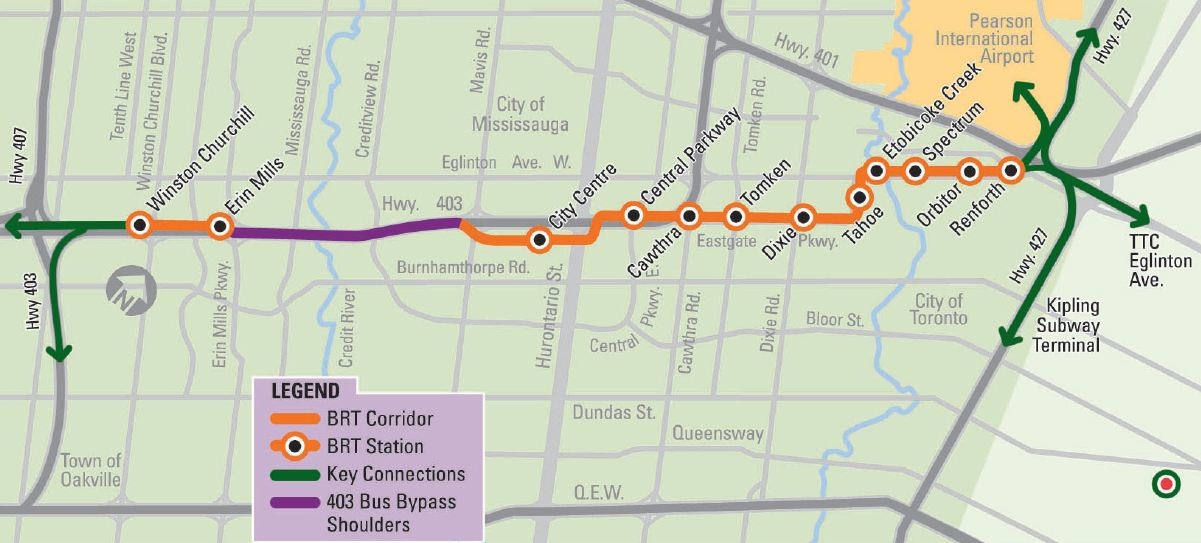Words by Chris Carriere
In our last issue, we covered the Hurontario-Main LRT (Light Rail Transit) project. As our For the Record series continues its ongoing examination of issues that taxpayers need to understand, we’re taking a first look at the BRT (Bus Rapid Transit) project. As taxpayers ourselves, we had a few important questions: How much will the project cost? Who’s paying? Who will benefit, and how? We did our research and consulted with Mississauga Transit’s Geoff Wright, Director of the Transportation Project Office, to get some answers.
The Basics
On completion, the BRT will be an 18-kilometre dedicated east-west corridor running across the city, connecting Winston Churchill at the west end to Renforth at the east. A “dedicated corridor,” in this case, means a road constructed exclusively for the BRT, saving commuters huge amounts of time. The BRT is an enhancement of existing transit lines, rather than an attempt at reinventing the wheel; for this reason, it’s highly cost-effective. It will connect to other transit systems, including the LRT, the TTC, GO Transit and the forthcoming Pearson LRT. The map below shows the BRT’s route. Think of it as a high-speed chute; someone living in Churchill Meadows or Port Credit can take a north-south running bus that connects to the BRT, then fly east or west at almost twice the normal rate, with no traffic to interfere.
“Some segments parallel Highway 403, then Eastgate Parkway, then the north side of Eglinton Avenue,” says Wright. “Significant portions are already nearing completion.”
The Impact
Ontario’s population will grow by as much as 4 million over the next 30 years, most of whom will settle in the GTA. In a city where the transit system is already—as many of us know from experience—stressed to the limit, maximizing efficiency is essential. Mississauga Transit’s upgrades, including the BRT, aim to increase MiWay ridership from 29 million in 2006 to 37 million by 2014. Travel times for commuters will be cut by as much as 50 percent at the high end. The percentage of the population within a 20-minute transit trip of City Centre will increase from 17 to 32 percent, benefitting employees by reducing their commute times, and employers by increasing productivity and geographically expanding the employee pool.
The Land Use Argument
Why a BRT for the east-west corridor and not an LRT? A big part of it comes down to land use. Whereas the LRT project aims to both (a) serve an existing need and (b) serve as an incentive to developers, according to Wright the BRT will result in “few immediate changes to land use.”
“The stations themselves are in a big hydro corridor. Having said that, the airport’s corporate centre along Eglinton Avenue will be the area most directly impacted by the project; some of the vacant parcels of land there are up for development.”
The Price Tag
At a total cost of $259 million, the BRT is a cost-effective solution for increasing the efficiency of east-west transit in the city. It will not involve a significant increase in the number of buses running; instead, the dedicated road will increase the speed of existing bus routes. The price is being split between all three levels of government, and between Mississauga Transit and GO Transit. Below is a breakdown of who-pays-what—compare this with the LRT, which will span 23 kilometres to the BRT’s 18, while costing approximately $1.3 billion.
• Canada: $83 million
• Ontario: $83 million (plus $5 million for private land)
• Mississauga: $59 million (plus $5 million for private land)
• GO Transit: $24 million
Investments this large are actually miniscule on a per-rider basis over a period of many years—especially when you consider that the BRT’s construction cost is only 75 percent of that of a major sports arena like the Air Canada Centre.
Fares and Upkeep
Although funding for construction is being split, upkeep and maintenance will fall mostly to Mississauga Transit. The increased expense will not be passed on to consumers; the fare for the BRT will, according to Wright, be the same as for mainstream MiWay service. However, because GO Transit buses will also be using the BRT route, GO will share some of the upkeep costs for the 12 stations.
